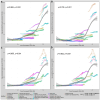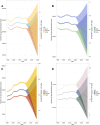Global burden of motor neuron disease: unraveling socioeconomic disparities, aging dynamics, and divergent future trajectories (1990-2040)
- PMID: 40349275
- PMCID: PMC12066381
- DOI: 10.1007/s00415-025-13130-z
Global burden of motor neuron disease: unraveling socioeconomic disparities, aging dynamics, and divergent future trajectories (1990-2040)
Abstract
Background and objectives: Motor neuron disease (MND) is a progressive neurodegenerative disorder associated with high morbidity and mortality. With global aging, the burden of MND is expected to increase, particularly in regions with rapidly aging populations. This study utilizes Global Burden of Disease (GBD) 2021 data to assess the global and regional MND burden from 1990 to 2021, examining trends by age, sex, and socio-demographic index (SDI), and projecting future trends to 2040.
Methods: Data from the GBD 2021 database for the years 1990-2021 were analyzed to evaluate age-standardized prevalence rates (ASPR), incidence rates (ASIR), mortality rates (ASMR), and disability-adjusted life years (DALYs) for MND across SDI regions, age groups, and sexes. Temporal trends were explored using joinpoint regression analysis, while future projections were generated using the Bayesian age-period-cohort (BAPC) model for 2021-2040.
Results: From 1990 to 2021, global MND prevalence increased by 68.43%, reaching 272,732 cases, while the age-standardized prevalence rate (ASPR) slightly declined, reflecting the influence of population aging. Although global incidence increased by 74.54%, the age-standardized incidence rate (ASIR) showed a modest decline, suggesting improvements in diagnostic practices. Mortality and DALY rates continued to rise globally, with high-SDI regions bearing the highest burden. Projections indicate that by 2040, global MND prevalence will decline slightly, while incidence, mortality, and DALYs will continue to rise in low- and middle-SDI regions due to aging populations.
Discussion: The global MND burden is heavily influenced by aging, particularly in high-SDI regions. Although incidence rates have slightly decreased, mortality and disability burdens are increasing, highlighting ongoing challenges in disease management and treatment. The findings stress the importance of age-targeted interventions, improving healthcare access, and addressing socio-economic disparities to mitigate the future impact of MND, particularly in low- and middle-SDI regions.
Keywords: Aging population; Future projections; Global burden of disease; Incidence; Mortality; Motor neuron disease; Socio-demographic index.
© 2025. The Author(s).
Conflict of interest statement
Declarations. Conflict of interest: The authors declare no competing interests. Ethical approval and consent to participate: An ethics approval and the consent to participate was not necessary. Consent for publication: All participants in this study consented to publication.
Figures






Similar articles
-
The global, regional, and national burden of paralytic ileus and intestinal obstruction, 1990 to 2021: a cross-sectional analysis from the 2021 global burden of disease study.Int J Surg. 2025 Feb 1;111(2):1773-1787. doi: 10.1097/JS9.0000000000002189. Int J Surg. 2025. PMID: 39784557
-
The global, regional, and national brain and CNS cancers burden and trends from 1990 to 2021.Sci Rep. 2025 Jun 1;15(1):19228. doi: 10.1038/s41598-025-04636-7. Sci Rep. 2025. PMID: 40451904 Free PMC article.
-
Divergent trajectories in pancreatic cancer burden among older adults (55+): a GBD 2021 analysis revealing China's dual epidemic of aging and population growth (1990-2045).Front Public Health. 2025 May 29;13:1600635. doi: 10.3389/fpubh.2025.1600635. eCollection 2025. Front Public Health. 2025. PMID: 40510574 Free PMC article.
-
Global, regional, and national burden of acute leukemia and its risk factors from 1990 to 2021 and predictions to 2040: findings from the global burden of disease study 2021.Biomed Eng Online. 2025 Jun 10;24(1):72. doi: 10.1186/s12938-025-01403-7. Biomed Eng Online. 2025. PMID: 40495176 Free PMC article.
-
Global, regional, and national burden of congenital anomalies of the kidney and urinary tract from 1990 to 2021, with projections to 2036: a systematic analysis of the global burden of disease study 2021.BMC Nephrol. 2025 Jul 1;26(1):334. doi: 10.1186/s12882-025-04269-y. BMC Nephrol. 2025. PMID: 40597805 Free PMC article.
References
-
- Batista EC, Zanoteli E, Monfardini F et al (2024) Longitudinal data collection in pediatric and adult patients with 5q spinal muscular atrophy in Latin America: LATAM RegistrAME study - a clinical registry study protocol. Einstein (Sao Paulo) 22:eAE1133. 10.31744/einstein_journal/2024AE1133 - PMC - PubMed
-
- Piga G, Fadda L, Borghero G et al (2024) Semantic behavioral variant frontotemporal dementia and semantic dementia associated with TARDBP mutations. Amyotroph Lateral Scler Frontotemporal Degener. 10.1080/21678421.2024.2439448 - PubMed
Publication types
MeSH terms
Grants and funding
LinkOut - more resources
Full Text Sources
Medical

